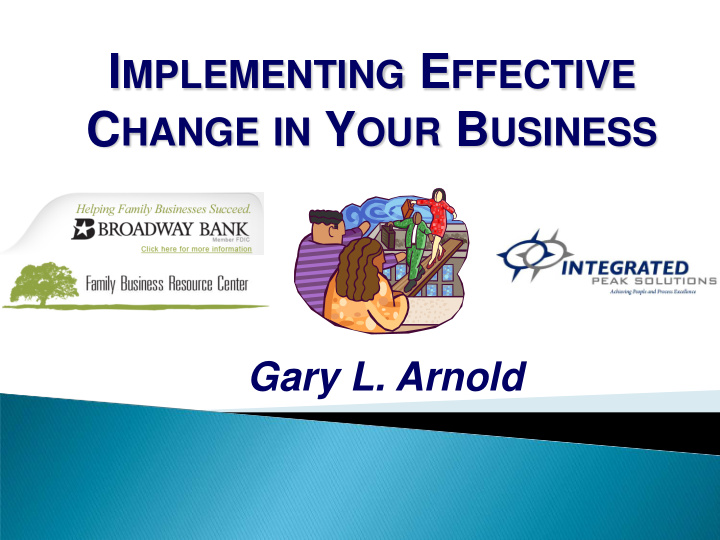



I MPLEMENTING E FFECTIVE C HANGE IN Y OUR B USINESS Gary L. Arnold
Sharpening Your Axe
Change Happens
Family Employment Policy Bullwinkle Bullhorns has been a family-owned and operated business since July 1, 1955. Its present owners strongly believe in continuing family involvement and values, which have led to the company’s success. To continue this success, the succeeding generations, if they desire employment at Bullwinkle Bullhorns must prepare for employment and possible career there. This plan is to help define in general terms the recommendations for employment of members of the succeeding generations of the Blowhorn family.
What’s Your Plan? Strategic Plan Implementation Phase Evaluation Phase Mission Why we exist Vision What we want to be Goals What we must achieve to be successful Specific outcomes expressed in Objectives measurable terms (NOT activities) Planned Actions to Initiatives Achieve Objectives Indicators and Measures Monitors of success Targets Desired level of performance and timelines
Organizational Model ENVIRONMENT STRATEGY STRUCTURE CULTURE SYSTEMS CORE PROCESS SUPPORTING PROCESSES RESULTS
Why Changes Fail • Complacency Lack of Teamwork • Don’t know where we are going • • Not understanding why • Insufficient authority vs. responsibility • Declaring victory too soon • No plan or not sufficient
The Emotions of Changing Change Implemented Change Needed Denial Energy Anger Enthusiasm Shock Buy In Fear Anxiety Frustration Impatience Depression Acceptance Confusion Skepticism Hope Stress Understanding
Resistance To Change • Loss of control/power • Helplessness • Loss or grief • Risk • Conflict or anger • Lack of Trust Having to “think differently”
Change Happens
The Boxes We Are In Culture Beliefs Procedures Systems Policies
Getting Out of the Box Emotional Logical True rue “Out ut o of t the Bo Box T x Thin inkin king” comes fro rom o our rig ur right bra rain in. Our ur left b bra rain in guid uides us us t thro roug ugh t the logic ical seque quence o of m makin king it it re realit ity.
Thinking Out of the Box Outside the Box Thinking 1. Connect all 9 dots with four straight lines 2. The lines must be continuous. (Where one stops the other continues.)
Remove the Barriers 1. Besides our walls and lids 2. The Oh no, that idea won’t work 3. The yea, buts 4. I’m comfortable
Change Alignment A desired common future . Our desired common future is based on trust .
Trust is Shown By Straight Talk Understanding Transparency Right your Wrongs Loyalty Deliver Results Confront Reality Clarify Expectations Accountability Communicate Openly Shared Values
Shared Values = Alignment Shared values are about the culture we encourage, the standards we adhere to, and the principles that should underpin the organization’s mission.
Management & Leadership Management = Processes, Procedures and Systems Leadership = People
Leadership vs. Management Transformation efforts All highly successful can be successful for a transformation efforts while, but often fail after combine good short-term results leadership with good become erratic. management. Short-term results are Leadership Transformation efforts possible, epically go nowhere. through cost cutting or acquisitions. Long term change is rarely achieved. Management
Six Steps to Change 1. Defining the “Why” 2. Building the “Change Team” 3. Developing a Vision and Plan 4. Implementing the Plan 5. Integrating the Change Vision 6. Making the Change “Stick”
Six Steps to Change 1. D EFINE THE “W HY ” • Examine the market and competitive realities. • Identify and discuss crises, potential crises, or major opportunities. • SWOT Analysis • Internal vs. external • Forced or planned • Organizational Model: Environment Strategy Structure Culture Systems Core Processes Support Processes Results
Six Steps to Change 2. B UILD THE T EAM • Put together a group with enough power to lead the change. • Ensure the team has a clear understanding of their mission. • Get the group to work together like a team. • Why - Mission • What - Roles Responsibilities • How - Relationships
Six Steps to Change 3. D EVELOP THE V ISION AND C HANGE P LAN • Create a vision to help direct the change effort. • Develop plans for achieving that vision utilizing SMART Goals. • Achievable • Understandable • Inspiring • Meaningful
Six Steps to Change 4. I MPLEMENT THE P LAN • Ensure “Top Down” implementation of change. • Revisit the “Plan” to make sure it is still viable. • Make changes as necessary to ensure vision achievement • Remove obstacles that may impede successful implementation of the plan.
Six Steps to Change 5. I NTEGRATE THE C HANGE V ISION • Use every system possible to constantly communicate the new vision and expectations. • Set the example • Ensure all leaders models the expected behavior/change. • Celebrate every victory!!
Six Steps to Change 6. M AKE THE C HANGE “S TICK ” • Ensure everyone realizes the connections between new behaviors and organizational success. • Develop ways to ensure employee development and succession are part of the shared values. • Integrate the expectation of : “Changes are a requirement of our business.” • Recruitment • Promotions
Habits of Success 1. Habits are learnable 2. Starting and completing important tasks 3. Positive addiction 4. Practice and repetition 5. No Shortcuts 6. 3 D’s • Decision • Discipline • Determination
Six Steps to Change 1. Defining the “Why” 2. Building the “Change Team” 3. Developing a Vision and Strategy 4. Implementing the Strategy 5. Integrating the Change Vision 6. Making the Change “Stick”
Referenced throughout
“Let him who says it cannot be done, stay out of the way of he who is already doing it.”
Final Thoughts
Recommend
More recommend